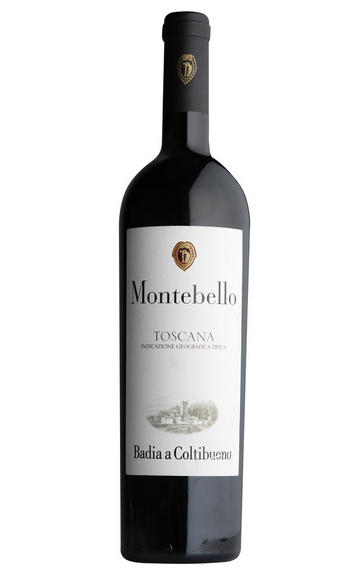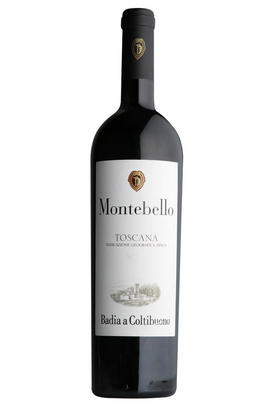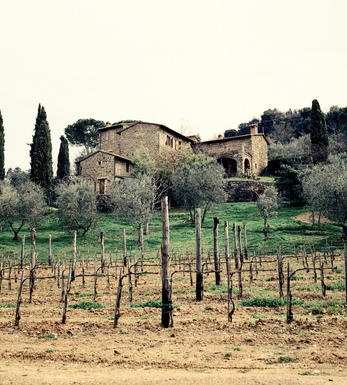
2018 Montebello, Badia a Coltibuono, Tuscany, Italy

Critics reviews
This certified organic wine represents an ambitious blend of Mammolo, Ciliegiolo, Pugnitello, Colorino, Sanforte, Malvasia Nera, Canaiolo, Fogliatonda and Sangiovese. The Badia a Coltibuono 2018 Montebello is always a hard wine to nail down precisely, considering the wide-reaching nature of the blend. The bouquet shows dark cherry and earth, and there are hints of cinnamon, tar and grilled herb. The alcohol content is a bit overboard, measuring 15.5% in this vintage, but the wine has the textural layering to absorb most of that heat. Only 4,400 bottles were made.
Badia a Coltibuono has been a certified organic estate since 2000. It is located in the hilly and thickly forested Monti area in the far south of Gaiole in Chianti where medium-high elevations and a cooler climate shape elegant wines. The focus here is squarely on the indigenous grapes of the region.
Drink 2023 - 2035
Monica Larner, Wine Advocate (September 2023)
Really pretty fruit here with currants and spices with some fresh flowers. Medium to full body. Fine tannins. Focused and real. From organically grown grapes. Give this three or four years to soften.
Drink after 2026
James Suckling, JamesSuckling.com (August 2023)
About this WINE

Badia a Coltibuono, Tuscany
Located in Gaiole in Chianti, Badia a Coltibuono’s history dates back to 1051, to the Vallombrosan order of monks, whose fine abbey (‘Badia’ ) still stands proud at the heart of the wine property; ‘Coltibuono’ means ‘good crop’ by the way. Current owners, the Stucchi Prinetti family have only been in residence since its purchase in1846 by great great grandfather and Florentine banker Michele Giuntini, cousin of the Selvapiana family of Rufina.
The present generation, siblings Emanuela, Roberto, Paolo & Guido, now run the show, bringing this most traditional of wine estates up to date. At 74ha it’s no garage operation, but it is fortunate in owning a significant slice of subzone/sottozona Monti in Chianti, whose excellent terroir is much prized.
Another asset is their stock of ancient Sangiovese clones, which they have used to replant key sites at higher densities of 7-8,000 Sangiovese plants per hectare; as opposed to the ultra traditional pattern of low densities of red and white grapes.
In 1996 they built a new winery in Monti, and with the 2003 harvest their fruit was certified ICEA organic. Roberto Stucchi Prinetti remarks that since going organic they’ve noticed that the fermentations have been easier to follow. He adds that though they’ve sacrificed journalist ‘Points’ they’re more than happy with the pale elegance of their wines. They also produce a Chianti Classico Riserva.

IGT Tuscany
IGT (Indicazione Geografica Tipica) Tuscany is a wine classification from Italy's Tuscany region. It is one of the official wine classifications recognized by the Italian government. IGT is a step below the highest classification, DOCG (Denominazione di Origine Controllata e Garantita), and above the DOC (Denominazione di Origine Controllata) level.
The IGT classification was introduced in 1992 to allow winemakers more flexibility in grape varieties and employ winemaking techniques while still ensuring a certain level of quality and geographical indication. This classification gives winemakers more freedom to experiment and innovate, deviating from the strict regulations of the DOC and DOCG classifications.
IGT Tuscany wines can be produced throughout the entire region of Tuscany, encompassing various sub-regions and terroirs within the area. This classification allows winemakers to use traditional Tuscan grape varieties, such as Sangiovese, and non-traditional grape varieties, including international ones like Cabernet Sauvignon, Merlot, Syrah, and others.
The IGT Tuscany classification gives winemakers the flexibility to create wines that showcase the unique characteristics of their specific vineyards and winemaking styles. It allows for experimentation with blending different grape varieties, using innovative winemaking techniques, and exploring new regional vineyard sites.
IGT Tuscany wines can vary greatly, from traditional and terroir-driven expressions to more modern and international styles. This classification has played a significant role in developing Super Tuscan wines, often IGT designated and known for their high quality and international recognition.
Overall, IGT Tuscany provides a platform for winemakers in the region to express their creativity and produce wines that reflect their unique vision while maintaining a connection to the rich heritage and traditions of winemaking in Tuscany.

Sangiovese
A black grape widely grown in Central Italy and the main component of Chianti and Vino Nobile di Montepulciano as well as being the sole permitted grape for the famed Brunello di Montalcino.
It is a high yielding, late ripening grape that performs best on well-drained calcareous soils on south-facing hillsides. For years it was blighted by poor clonal selection and massive overcropping - however since the 1980s the quality of Sangiovese-based wines has rocketed upwards and they are now some of the most sought after in the world.
It produces wines with pronounced tannins and acidity, though not always with great depth of colour, and its character can vary from farmyard/leather nuances through to essence of red cherries and plums. In the 1960s the advent of Super Tuscans saw bottlings of 100% Sangiovese wines, as well as the introduction of Sangiovese/Cabernet Sauvignon blends, the most famous being Tignanello.


Buying options
Add to wishlist
Description
This certified organic wine represents an ambitious blend of Mammolo, Ciliegiolo, Pugnitello, Colorino, Sanforte, Malvasia Nera, Canaiolo, Fogliatonda and Sangiovese. The Badia a Coltibuono 2018 Montebello is always a hard wine to nail down precisely, considering the wide-reaching nature of the blend. The bouquet shows dark cherry and earth, and there are hints of cinnamon, tar and grilled herb. The alcohol content is a bit overboard, measuring 15.5% in this vintage, but the wine has the textural layering to absorb most of that heat. Only 4,400 bottles were made.
Badia a Coltibuono has been a certified organic estate since 2000. It is located in the hilly and thickly forested Monti area in the far south of Gaiole in Chianti where medium-high elevations and a cooler climate shape elegant wines. The focus here is squarely on the indigenous grapes of the region.
Drink 2023 - 2035
Monica Larner, Wine Advocate (September 2023)
wine at a glance
Delivery and quality guarantee